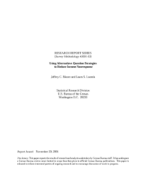
An official website of the United States government
Here’s how you know
Official websites use .gov
A .gov website belongs to an official government organization in the United States.
Secure .gov websites use HTTPS
A lock (
) or https:// means you’ve safely connected to the .gov website. Share sensitive information only on official, secure websites.
-
//
- Census.gov /
- Library /
- Census Working Papers /
- Using Alternative Question Strategies to Reduce Income Nonresponse
Using Alternative Question Strategies to Reduce Income Nonresponse
Using Alternative Question Strategies to Reduce Income Nonresponse
Abstract
Item nonresponse is a continuing issue for surveys which attempt to collect income data. As with any survey topic, elevated levels of nonresponse necessitate additional (and often costly and time-consuming) repair measures, both in the field and during data processing, and increase the uncertainty surrounding income estimates derived from survey data. The importance of income data for social policy analysis adds an extra impetus for developing effective techniques to bring income nonresponse under better control. Recently, researchers have begun to report some success in reducing income nonresponse through the use of "unfolding brackets" and a variety of other types of closed-ended income range reporting options.
This paper reports the results of an experimental test of a new form of income range reporting, the intent of which was to address both cognitive and motivational barriers to income reporting, without adding to the tedium of the interview interaction. The experiment was conducted as part of the Census Bureau's 1999 Questionnaire Design Experimental Research Survey (QDERS), an RDD/telephone survey which served as the vehicle for several methodological experiments. The test of relevance here compared a standard annual income amount reporting task for several common types of assets to a new form of income range reporting which we term "implicit brackets." In essence, the implicit bracket approach first asks the respondent whether the amount exceeds some minimum threshold ($10 to $100, depending on the asset type), and then, if yes, asks for a report of the income amount "to the nearest X dollars," with X varying from (in this case) $5 to $50, depending on the type of asset.
Results of the experiment suggest that the implicit brackets approach had small but consistently positive effects on nonresponse, primarily through a reduction in "don't know" nonresponse. We find insignificant and inconsistent effects on average income amounts reported, and similarly inconsistent effects on response distributions. We find no reduction in the precision of income reports generated by the implicit brackets approach; in fact, those reports were actually less likely to be rounded than were control treatment reports. Interviewers perceived significant benefits to the implicit brackets approach, in terms of respondent ease and the accuracy of reports. We acknowledge the limitations of the QDERS test, but nevertheless view these results as a promising first step toward the development of improved survey procedures for capturing income data.
Others in Series
Working Paper
Working Paper
Working Paper
Share
Related Information
Some content on this site is available in several different electronic formats. Some of the files may require a plug-in or additional software to view.
 Yes
Yes
 No
NoComments or suggestions?


Top

